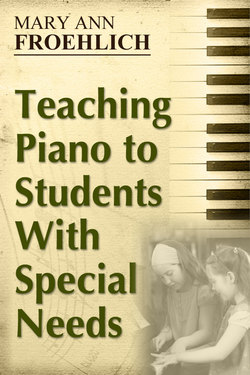Читать книгу Teaching Piano to Students With Special Needs - Mary Ann Froehlich - Страница 3
На сайте Литреса книга снята с продажи.
Introduction
ОглавлениеDuring his first piano lesson Dylan told me, “My last piano teacher and I had a hard time. But I heard that you like teaching kids with tricky brains.” His description is the best one I’ve heard yet. I’m a “Tricky Brain Piano Teacher.” My goal with each of my students is to teach them according to how their individual brains work.
Trained as a music therapist, teaching piano to students with special needs was a natural step in my journey as a Suzuki piano teacher. I truly believe that the ability to make music changes people’s lives. I’ve also come to the conclusion that each of my students has special needs, whether he or she has a legitimate diagnosis, life crisis, or simply a bad day. Students of all ages and abilities need individualized nurturing and instruction.
You may be reading this book because you have students with special needs in your studio or are considering this avenue of teaching. Perhaps you are a music therapist who wants to teach keyboard skills to some of your clients. Special needs can take several forms. Some students may have Down syndrome, learning disabilities, or autism. Others may be blind or physically challenged. Some may be adults who suffer with depression or are recovering from childhood abuse. Others may be teens at risk who struggle with addiction. Some may be senior adults who are learning a new skill to keep their brains active and healthy. Whether you are a music teacher or therapist, you will realize that learning to make music through playing an instrument is healing in itself.
The population of special needs students seems to be increasing. Experts wonder if disorders, such as autism, learning disabilities, or bipolar disorder, are actually on the rise or if the diagnostic process is simply more thorough today. Whether you seek it out or not, you will probably have the opportunity to work with students who experience a variety of special needs. Hopefully this book will encourage you while giving you tangible techniques for facing this challenge as you enjoy the privilege of sharing music with special learners.
This short book is intended to be a concise, practical guide, a starting point for your own journey. It will not replicate the information already available in current outstanding books about music therapy and special music education. These resources will be listed in later chapters. This book offers one approach for teaching piano to special learners.
You may not know that J. S. Bach faced a similar challenge. You are probably familiar with the children of J. S. Bach who went on to become well-known composers in their own right, most notably C. P. E. Bach and J. C. Bach. J. S. Bach was proud of his musical family and talented offspring. Yet one of J. S. Bach’s children was a child with special needs. He was termed “feeble-minded.” I sometimes wonder if J. S. Bach tried to share his music with this less talented son. Did J. S. Bach attempt to teach this child to make music or did he assume that his son was incapable of learning? The question intrigues me. J. S. Bach was known to be an impatient, difficult teacher. Once he even drew a dagger on a student who frustrated him. J. S. Bach was not a nurturing educator with his students. Perhaps J. S. Bach was so gifted that he had no tolerance for teaching struggling students. Hopefully he was more compassionate with his own son.
May this path of exploring the world of music with special learners inspire and intrigue you. May having the gift of music encourage you to share it generously with others, especially those who find learning to make music challenging but revel most in its joy.
Music is the medicine of the mind.
John Logan
Song is the pen of the soul.
Rabbi Chaim Drizin
